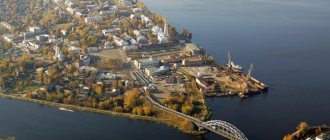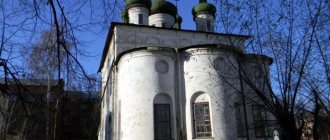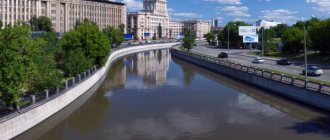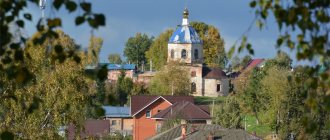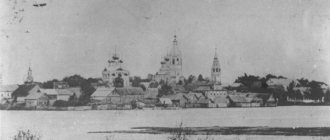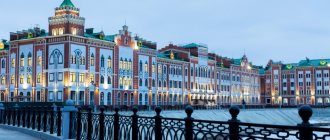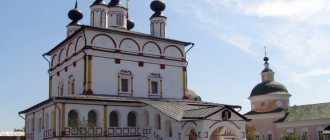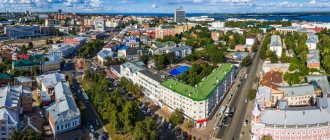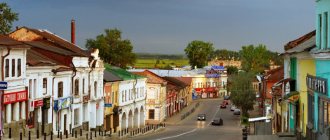Tikhvin is an unusual city, famous for its ancient architecture. There are especially many monasteries and churches in Tikhvin, modern and almost destroyed. There are also chapels, house museums, monuments, and sculptures in the city.
Tikhvin was built back in 1383 and immediately began to grow rapidly. Currently, it combines a rich cultural, spiritual and historical heritage and developing modern industry.
Attractions marked on the city map:
Theotokos Dormition Monastery
Address: st. Tikhvinskaya, 1 Phones: +7 (81367) 51-084, +7 (911) 979-10-88 Website: https://www.tihvinskii-monastyr.ru/ Opening hours: summer - daily from 06:00– 21:00, winter period - Monday - Friday from 06:00-19:30, Saturday from 06:00-20:30, Sunday 06:00-19:30
The Mother of God Assumption Monastery is one of the main pilgrimage centers in Russia. The monastery is distinguished by an unusual refectory building, a beautiful belfry and cells.
It was built in 1560 by order of Ivan the Terrible on the site of the appearance of the icon of the Mother of God, which later became the most important exhibit. During the war, the icon was taken to Pskov, then to Moscow, and a little later - abroad. Only in 2004 was she able to be returned to the monastery.
Transfiguration Cathedral
The Cathedral of the Transfiguration is located in the central square of the city. The main attraction of the cathedral is the Tikhvin Icon, in whose miraculous power pilgrims believe.
House-Museum of Rimsky-Korsakov
Address: Rimsky-Korsakov street, 12 Telephone: 8-136-751-509 Website : https://museum.ru/m244 VK: https://vk.com/club48514092 Opening hours: 10:00-17:00, Monday - closed Cost : 1st floor of the exhibition - adults 100 rubles, pensioners and schoolchildren over 16 years old - 60 rubles, mezzanine (open from May to October) - 10 rubles. Excursion (1st floor of the exhibition) 350 rub./group (group from 1-5 people), additional cost of entrance ticket. Group of more than 6 people - 50 rub./per person. plus the cost of entrance tickets. Mezzanine — 10 rub./per person. plus entrance fees
The museum's exhibition is dedicated to the life and work of Rimsky-Korsakov. It was in this house that the composer spent his entire childhood.
Museum visitors will be able to join the creative life of Rimsky-Korsakov, listen to music, study posters, claviers, and librettos. The architecture of the house and garden plot has been almost completely preserved from the time of the composer’s life.
Vvedensky Convent
The monastery was built in 1383 on the first site of the miraculous appearance of the icon of the Virgin Mary. Queen Daria the Blessed lived here for a long time.
Natural Park "Vepsian Forest"
Address: Tikhvinsky district, 1st microdistrict, 42 Telephone: (department of specially protected natural areas), (directorate), park administration +7(81367) 73-969, 78-839, 44-491 Website: https://www .vepsles.spb.ru/ How to get there: by bus from Pashozero, Korbenichy, Shugozero, Lukino stations (all days except Saturday). You can also get to the park from Tikhvin station (on Fridays and Sundays).
Rural, educational, sports, and extreme tourism are developed in the park. You can also hunt and fish here in specially designated areas. Children's ethnological expeditions are conducted, and in the summer there is a field ecological camp for schoolchildren. Tourists can stay in guest houses in the nearest villages - Pashozero, Biryuchevo, Lukino and others.
Tikhvin water system
Address: Rimsky-Korsakov street, Tikhvinka river, next to house number 47.
The Tikhvin water system is an important trade route connecting the Baltic Sea and the Volga. The dam and lock in the city of Tikhvin near the Assumption Monastery were reconstructed in 2014.
These structures are completely made according to ancient drawings and technologies. All buildings are made of wood, and the frame is filled with cobblestones.
The gateway is in working order, giving the impression that the system is still in operation as it was centuries ago. From the dam there is a wonderful view of the Assumption Monastery.
Historical-Memorial and Architectural-Art Museum
Address: Tikhvinskaya street, 1 Telephone: 8-813-675-18-20 Website : https://lenoblmus.ru/museum/tikhvinskiy_muzey Opening hours: 10:00–17:00, closed Monday Entrance fee: Exhibition " House of the Most Pure Mother of God" and State cells: schoolchildren - free, adults - 120 rubles, pensioners - 100 rubles. Archaeological exhibition: schoolchildren - free, adults - 80 rubles, pensioners - 60 rubles. Single ticket for all categories - 250 rubles. Excursions from 120 rub. Detailed information on all excursions and benefits here
The museum presents exhibitions dedicated to noble and merchant culture, the life of rural residents, various crafts, and the history of the Tikhvin region.
The main exhibition of the museum is dedicated to the icon of the Virgin Mary. The museum is located in the state and archimandrite's cells of the Bogoroditsky Monastery.
Church of the Icon of the Mother of God “The Sign”
Address: Znamenie street, 1 Phone: 8-813-67-58-366 Opening hours: 10:00-17:00 daily, except Monday Website: https://znamenie-hram.ru/
The first mentions date back to the 16th century. In the 19th century, the temple was completely rebuilt. The main shrines are particles of the relics of the holy sisters of Diveyevo. Many parishioners say that prayers in this temple really work miracles.
Video
- An interesting video from Channel One about Tikhvin - the City of Military Glory:
- Video tour of the city:
Source: https://kudarf.ru/szfo/leningradskaya-oblast/tihvin-dostoprimechatelnosti.html
Tikhvin: attractions and unique places of the city
Tikhvin (Leningrad region) is a city famous throughout the world for its miraculous icon of the Mother of God. It was laid on the spot where, according to legend, the Holy Virgin appeared. The sights of Tikhvin are associated with important historical events, Orthodoxy and the development of Russian culture.
Temples and monasteries
The city of Tikhvin, whose sights are inextricably linked with Russian culture, is famous for its shrines. Among them:
Vvedenskaya monastic monastery (women's)
Temple of the Icon "The Sign"
Read: Plyos - the charm of a small ancient town
Church of Job the Long-Suffering
Museums
In the city you can get acquainted with historical, cultural and spiritual attractions, presented in the form of rare exhibits. They are exhibited in museums:
Historical and architectural-artistic
At the beginning of the 20th century, the museum had thousands of exhibits, among which were rare valuable icons, historical artifacts, and ancient manuscripts. During World War II, the Nazis plundered the collection and took away some particularly valuable items. Some of the exhibits burned in a fire caused by an exploding shell. The remains, according to witnesses, were dismantled by local residents. The restoration of the museum began in the mid-20th century by Tikhvin teachers. Currently, more than 30 thousand exhibits are stored within the walls of the cells. They are presented in 6 permanent exhibitions. One of them is dedicated to the miraculous icon. Photos describing important events tell the amazing history of this shrine.
Rimsky-Korsakov
Read: Warrior City Shlisselburg
Ruins of the locks
Natural attractions
You can get acquainted with the natural attractions of the city in several places. Among them:
"Vepsian forest"
Shugozero
Zakharovsky Park
How to get there and where to stay
You won't have to worry about where to stay. Tikhvin hotels are located everywhere and offer rooms in different price categories.
In the center there is a large hotel "Tikhvin", in the historical part of the city the doors of the "Podvorye" are open for tourists, and guest houses of the "Viking" complex were built near the forest.
When planning a trip, you should focus on the nearest city – St. Petersburg. You can get from the northern capital by car, bus, train or train.
- By car the journey takes about 3 hours.
- By bus the journey will take 30-40 minutes longer.
- The train is not the most convenient option, since it travels in this direction only in the evenings and the route takes about 4 hours.
- Travel time by train is almost the same as by bus, but tickets cost twice as much.
Since there are different ways to get to Tikhvin, each traveler will decide for himself which way is more convenient.
Source: https://gulaytour.ru/tixvinskoe-nasledie.html
The distance from St. Petersburg to Tikhvin, which can ruin your mood
To make everything fair, let's start not with descriptions of the delightfully quiet, cute streets of a small town, but with numbers.
215, 217 or 219 kilometers. This is the distance from St. Petersburg to Tikhvin. Online services for measuring mileage between points A and B differ in their readings. But in this case, you can’t measure it with a ruler. But you must admit, two or three “extra” kilometers will no longer matter much when the remaining 215 are already behind you.
What are these numbers for? To explain to you: this city is located further than the usual Pavlovsk, Gatchina and even Vyborg. If you decide to see its sights, the drive will take about two and a half hours one way. It’s better to count on a three-hour journey, so that there are no disappointments like “we’ve been traveling for a long time, but Tikhvin is still not there.”
Tikhvin: sunset over the field
Trip to Tikhvin for three days
I have long dreamed of going to Tikhvin, an ancient Russian city in the Leningrad region. We thought about it all the time, but somehow it worked out. Apparently, it was waiting for its opportunity. And then in May 2014, an opportunity presented itself. My husband had an urgent business trip. And we decided to combine business with pleasure and went to Tikhvin.
Tikhvin on the map of Russia: nature, geographical location and climate
The Tikhvin district occupies the south-eastern part of the Leningrad region, within the Volkhov Lowland and the Vepsov Upland .
The climate in the area is moderate continental with mild snowy winters (- 7-11°C) and cool, humid summers (+ 15-22°C).
The surroundings of Tikhvin are located in the southern taiga zone with an abundance of rivers, lakes, and swamps. The dominant plant species are pine, spruce, birch and aspen, and there are many medicinal herbs.
The wealth of natural complexes is presented in the Vepsian Forest reserve - one of the main attractions of Tikhvin. Not far from the city is the village of Shugozero, a popular holiday destination for Tikhvin residents.
Sights of Tikhvin
Category: Sights
Archaeological finds on the territory of the modern city of Tikhvin, in the Leningrad region, indicate that the first intelligent tribes lived here in the second century BC.
In the first century of our time, the Baltic-Finnish Vepsian tribe already settled here.
The close location to trade and sea routes allowed Tikhvin to quickly grow into a modern, developed city with many interesting attractions.
Natural Park "Vepsian Forest"
The blond, blue-eyed Vepsians, who inhabited the territory of Tikhvin even before the birth of Christ, were a rather mysterious people, whose life took place mainly in the dense northern forests.
Today, in these forests of the Leningrad region lies the Vepsian Forest park, which has long become a local attraction of both natural and historical significance. The park's guards strictly monitor the preservation of the natural resources of the area, as well as the historical monuments of the ancient Vepsians.
In the village of Pashozero, not far from Tikhvin, there is a museum of the Vepsian Forest Park, where two halls display exhibitions telling about the life and way of life of the ancient tribe, as well as the flora and fauna of the reserve.
Monument "Tank"
The legendary and practically invincible T-34 vehicle, elevated to a pedestal on the site of the Pashkin (Pash) cordon, where German fortifications were located at the beginning of the Great Patriotic War.
Here, a tank company led by Hero of the USSR M.K. Kuzmin died in a fierce battle.
Today, this landmark of Tikhvin on the northwestern exit from the city is a place of worship for townspeople on military holidays.
Mother of God Assumption Monastery
By decree of Ivan IV the Terrible, this monastery was founded in Tikhvin under the leadership of Pimen in 1560. Its pearl, main shrine and value is the Icon of the Tikhvin Mother of God Hodegetria, whose fate, perhaps, was much more interesting than the fate of the attraction itself.
When the monastery was closed by the new Soviet authorities in the 1930s, the image was transferred to the local history museum. From there she was taken before the German offensive to Riga, then to Germany and then to the USA.
Only in 2004, 9 years after the opening of the monastery, the miraculous icon, according to the behest of the late Bishop Garklavs, was returned to its native land.
Architectural-Art and Historical-Memorial Museum
This landmark of Tikhvin represents two objects that are most interesting from different points of view. On the one hand, this is a rich museum, which displays exhibits telling about the long and rich history of the city, as well as exhibiting crafts and arts by local craftsmen and famous Russian authors.
On the other hand, the museum is located in the ancient chambers of the Bogoroditsky Monastery built in the early 16th century, which makes it both an architectural and Orthodox relic. Almost all the buildings of the monastery were erected no later than the 17th century and have been perfectly preserved to this day.
Of particular interest is the unique five-tent belfry with three tiers built in 1600.
Monument "Cannon"
Another monument designed to remind the townspeople and guests of Tikhvin of the invaluable role of its residents in the fight against the fascist invaders. The ZIS-3 divisional gun, 76 mm caliber, model 1942, stands in the memorable Mananovo field at the entrance to the city. Locals simply call the landmark “The Cannon” and every year on May 9th they lay flowers on the pedestal at its base.
House-Museum of Rimsky-Korsakov
A house of classical 19th-century architecture with enfilades and a mezzanine, where the famous Russian composer Nikolai Rimsky-Korsakov was born in 1844.
The building, which is a monument of federal significance, now houses a museum named after the great maestro, where you can get acquainted with his works, personal belongings, posters and notes of the master, as well as the virtually unchanged furnishings of the rooms of the 19th century.
In addition to viewing museum exhibits, in the composer’s house-museum you can regularly attend a variety of musical and literary evenings, where visitors listen to and discuss classical compositions, as well as thematic exhibitions. The house is surrounded by a picturesque park with a wide variety of vegetation and pleasant landscape design.
Znamenskaya Church
The current chapel of the martyrs Lavr and Frol, built in 1771. In the 19th century, a temple was erected next to the church, which exactly one hundred years later was destroyed by the henchmen of the new government.
After perestroika, the landmark was revived through the zeal of the residents of Tikhvin and Metropolitan John of St. Petersburg.
During its initial construction, the temple bore obvious features of Western architecture, but after perestroika it acquired a classic Russian look with a somewhat provincial touch, which gives it a special charm.
Source: https://obzor-mest.ru/dostoprimechatelnosti-tixvina/
Tikhvin: interesting places and attractions
The ancient Russian city of Tikhvin is famous for its ancient architectural monuments. The city was built back in 1383 on both banks of the Tikhvinka River, and it developed quickly. Many monasteries and churches were built, some of which are destroyed today. There are those that were built relatively recently.
The city has become a real monument of spirituality and culture. It organically combines the rich heritage of history and modern industrial enterprises. Today it is the administrative center and transport hub of the district of the same name in the Leningrad region of Russia. It is home to over 61 thousand people.
Tourists are attracted here by interesting objects of Russian architecture, monuments, and houses where famous people lived.
Railway station
In 1904, the Tikhvin railway station was opened. The station building, made in the Russian-Byzantine style, is decorated with rich stucco and pilasters. The protruding portal had a figured pediment. One of the attractions was a beautiful small chapel.
In 1995, the building was restored. In 2004, the Tikhvin Icon of the Mother of God returned to Tikhvin from an American trip. In connection with this significant event, the station building was completely renovated.
Today the station serves ten railway lines.
Gostiny Dvor
One of the architectural monuments of the 18th century is the Gostiny Dvor, the project of which was originally developed for Tver. The building is L-shaped. Its classical facades are decorated with three figured attics and covered with yellow plaster. The windows on the first floor had a corrugated design.
Until 1917, there was a lively trade and artisans worked here. Then the building was nationalized and barracks for soldiers were placed in it. The market that operated here in the middle of the last century was closed. The historical appearance of the building was restored only in 2005.
Today it adorns the architectural ensemble of the city.
Palace of Culture
In 1982, the Kirov Plant Palace of Culture was opened in the city, which was named after Rimsky-Korsakov. Its area is over nine thousand square meters, and the main concert hall, together with the balcony, can accommodate 860 spectators.
During a major renovation in 2009, the palace was modernized. It now has a modern cinema, dance halls, and a restaurant. High-quality equipment has been installed, allowing concerts and theatrical performances of any level to be held.
Dozens of creative groups work in the palace
Karl Marx str., 30 Rimsky-Korsakov House-Museum
The estate, where the family of the great Russian composer lived, was built at the beginning of the 19th century. It is recognized as an architectural historical monument. It is a one-story mansion with a superstructure and a picturesque garden.
Today it is under the jurisdiction of the State House-Museum of N.A. Rimsky-Korsakov. Much has been done to ensure that visitors learn as much as possible about the life and work of the great musician.
Here you can listen to his works, get acquainted with the musical literature he studied, and hear his voice recorded.
Rimsky-Korsakov st., 12 Convent
In the 19th century, a convent was founded in Tikhvin. This was done in memory of the rescue of the family of Emperor Alexander III while traveling by rail.
Tikhvin: holy places and pristine nature
The first mention of the village, which appeared near the monastery walls, dates back to the end of the 14th century. During the Great Patriotic War, the “road of life” passed here - the only road across Lake Ladoga that connected besieged Leningrad with the country.
In winter, it ran directly on ice, and during navigation, on water. Today Tikhvin is a regional center with a population of about 60 thousand people. In the historical part of the city, several ancient stone houses have been preserved: in particular, Gostiny Dvor and the Volozhbensky house.
Interesting examples of wooden architecture can be seen on Orlovskaya Street.
The famous Russian composer Rimsky-Korsakov spent his childhood in the city of Tikhvin. On the street named after him there is a museum of the composer. And in the building of the former Regimental Church there is a concert hall named after him.
Tikhvin is famous for its wonderful landscapes.
You can appreciate this in Zakharovsky Park, where there are several observation platforms with beautiful views of the complex of the Tikhvin Mother of God Assumption Monastery.
Another park is Hérouville-Saint-Clair on the coast of the Vyazitsky stream. It is named after its sister city in France. Also among the city's attractions are two dozen bridges and bridges.
But the main thing you need to see in Tikhvin is the Tikhvin Mother of God Assumption Monastery. The museum on its territory houses more than 30 thousand exhibits related to the history of the region.
In addition, there is a pilgrimage service here. Lunch for pilgrims is organized in the refectory at the Church of the Intercession.
The monastic meal is quite modest: Lenten soup, fish with a side dish, cabbage salad, compote with a bun and Cahors for dessert.
As for the traditional food in these parts, it is important to know that Lake Ladoga and the surrounding forests have always generously provided the Tikhvin residents with fish, mushrooms and berries. Therefore, when in the city, you should give preference to such dishes as, for example, king fish and salted milk mushrooms in sour cream.
Thanks to the influence of neighboring Karelia, people here like to cook Karelian folk soup. It is called “Kalaruokka” and is made from pickled fish. Before serving the fish soup, the broth is passed through birch charcoal to impart a unique flavor to the dish cooked over a fire.
For dessert, you should definitely try jam or any baked goods with northern berries - cloudberries, blueberries.
You should plan your visit to Tikhvin in such a way as to be able to capture the radiant sunset over the domes of the churches and cathedrals of the Assumption Monastery. This magical picture will remain in my memory for a long time!
Routes on the map of Tikhvin. Transport infrastructure
You can get to the city by road and rail. The bus station and railway station are located on Station Square. Trains pass through Tikhvin on the St. Petersburg-Vologda line, which connects the region with the cities of the North, the Urals, and Kazakhstan.
- The optimal way to get to Tikhvin is, it departs daily from the Ladozhsky station in St. Petersburg in the evening.
- On Sundays, trains go from Moskovsky station (at 7:30) and from Ladozhsky (at 14:20) to Tikhvin.
- Suburban trains depart from Volkhovstroy-I station four times a day in the Tikhvin direction. Through the Volkhov from Tikhvin by train you can get to Karelia and the Murmansk region.
The roads passing through Tikhvin have the following directions:
- The federal highway A144 “Novaya Ladoga – Vologda” leads to the east: to Cherepovets and Vologda, from where you can go to the North of Russia or the Volga region.
- Along the P-21 from St. Petersburg with a turn from Ladoga to A-144, buses run from St. Petersburg to Tikhvin and back several times a day.
- At the intersection of highways A144 and P36 there is a monument to Soviet pilots from the Great Patriotic War.
- Along the P36 you can get to Lodeynoye Pole and further to Karelia and the Murmansk region. A bus passes through Tikhvin every week from Cherepovets to Petrozavodsk and back.
- In the southern direction in the summer from Tikhvin you can go to Novgorod.
Bus routes connect Station Square with all cultural sites and suburbs of Tikhvin. Road conditions and traffic jams can be conveniently observed online on a satellite map of Tikhvin.
